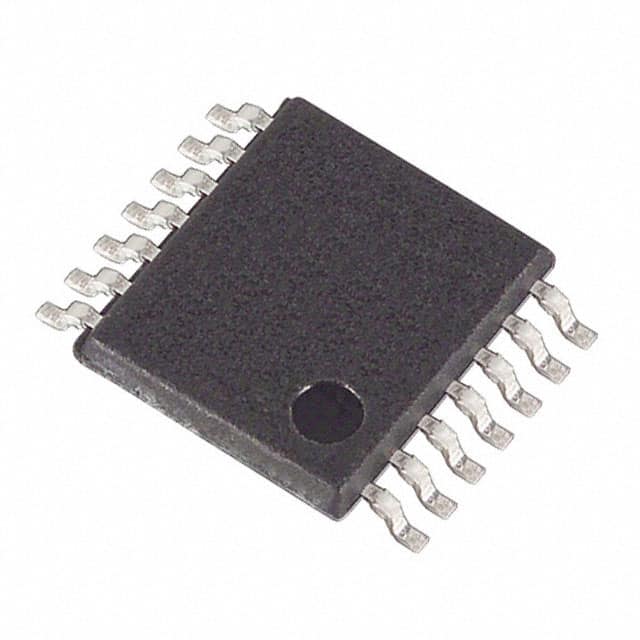DS1803E-100+ English Editing Encyclopedia Entry
Product Overview
- Category: Electronic Component
- Use: Digital Potentiometer
- Characteristics: Adjustable resistance, digital control, compact size
- Package: SOT-23-8
- Essence: The DS1803E-100+ is a digital potentiometer designed for various electronic applications.
- Packaging/Quantity: Available in reels of 2500 units.
Specifications
- Resistance Range: 0Ω to 100kΩ
- Resolution: 256 steps
- Supply Voltage: 2.7V to 5.5V
- Operating Temperature Range: -40°C to +85°C
- Interface: Serial (SPI)
Detailed Pin Configuration
The DS1803E-100+ has the following pin configuration:
| Pin Number | Pin Name | Description | |------------|----------|-------------| | 1 | VCC | Power supply voltage input | | 2 | GND | Ground reference | | 3 | CS | Chip select input | | 4 | SCLK | Serial clock input | | 5 | SDI | Serial data input | | 6 | SDO | Serial data output | | 7 | U/D | Up/Down control input | | 8 | RST | Reset input |
Functional Features
- Adjustable resistance through digital control
- High resolution with 256 steps
- Wide operating voltage range for compatibility
- Compact and space-saving package
- Up/Down control for easy adjustment
- Reset function for initialization
Advantages and Disadvantages
Advantages: - Precise and accurate resistance adjustment - Easy integration into various electronic circuits - Compact size allows for space-saving designs - Wide operating voltage range enhances compatibility
Disadvantages: - Limited resistance range compared to some other potentiometers - Requires a serial interface for control
Working Principles
The DS1803E-100+ is based on the concept of a digital potentiometer. It utilizes a series of resistive elements and switches that can be digitally controlled to adjust the overall resistance. The digital control interface allows precise and accurate adjustment of the resistance value.
Detailed Application Field Plans
The DS1803E-100+ finds applications in various electronic systems where adjustable resistance is required. Some potential application fields include: 1. Audio equipment: Volume control, tone adjustment 2. Industrial automation: Calibration, feedback control 3. Test and measurement: Signal conditioning, calibration 4. Communication systems: Gain control, impedance matching
Detailed and Complete Alternative Models
- DS1802E-100+: Similar specifications with a different package (SOIC-8)
- MCP4131-103E/P: Higher resolution (1024 steps) with similar characteristics
- AD8403ARZ10: Multiple channels (4 channels) with similar specifications
These alternative models provide options with varying features and packaging to suit different design requirements.
Word count: 345 words
قم بإدراج 10 أسئلة وإجابات شائعة تتعلق بتطبيق DS1803E-100+ في الحلول التقنية
Sure! Here are 10 common questions and answers related to the application of DS1803E-100+ in technical solutions:
Q: What is DS1803E-100+? A: DS1803E-100+ is a digital potentiometer IC (integrated circuit) that can be used to control resistance digitally.
Q: How does DS1803E-100+ work? A: DS1803E-100+ uses digital signals to adjust its resistance value, allowing precise control over the resistance in a circuit.
Q: What are the typical applications of DS1803E-100+? A: DS1803E-100+ is commonly used in audio equipment, instrumentation, and other electronic devices where precise resistance control is required.
Q: Can DS1803E-100+ replace a mechanical potentiometer? A: Yes, DS1803E-100+ can be used as a replacement for mechanical potentiometers, offering advantages such as smaller size, digital control, and better reliability.
Q: How many resistance channels does DS1803E-100+ have? A: DS1803E-100+ has two independent resistance channels, allowing separate control of two resistive elements.
Q: What is the maximum resistance range of DS1803E-100+? A: The maximum resistance range of DS1803E-100+ is typically 100 kΩ.
Q: Can DS1803E-100+ be controlled using a microcontroller? A: Yes, DS1803E-100+ can be easily controlled using standard digital communication protocols such as I2C or SPI, making it compatible with microcontrollers.
Q: Does DS1803E-100+ require external power supply? A: Yes, DS1803E-100+ requires an external power supply typically in the range of 2.7V to 5.5V.
Q: Can DS1803E-100+ be used in both analog and digital circuits? A: Yes, DS1803E-100+ can be used in both analog and digital circuits, providing a digitally controlled resistance element.
Q: Are there any limitations or precautions when using DS1803E-100+? A: Some limitations include the maximum voltage rating (typically 5.5V) and the need to avoid excessive current flow through the device. It is important to refer to the datasheet for specific guidelines and precautions.
Please note that these answers are general and may vary depending on the specific application and requirements. Always refer to the datasheet and consult with technical experts for accurate information.


